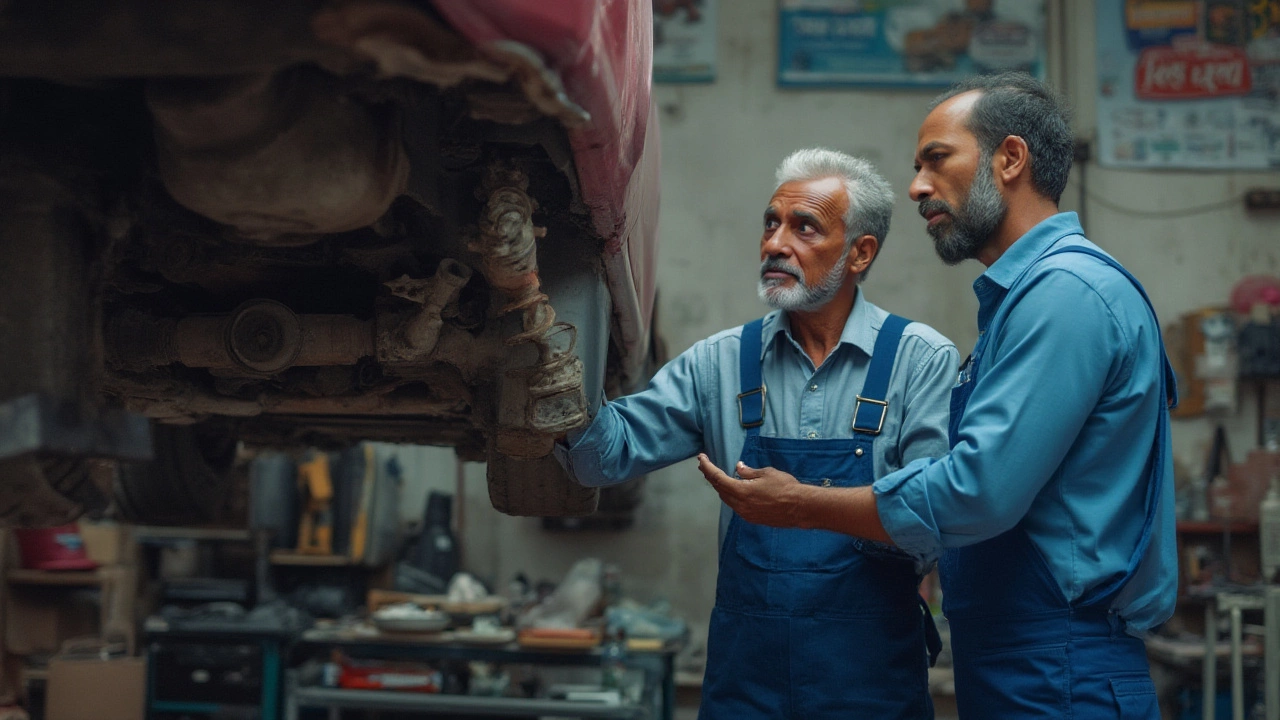 Jul, 23 2025
Jul, 23 2025
Ever felt every single pothole right in your spine or heard people bragging about their lowered, stiffer suspensions, only to see them rattle over pebbles like maracas? That’s not just a style statement—it’s a science experiment gone a little too rough on the kidneys. If your car’s springs are too stiff, it can change everything from how you take a corner to how safe you feel on your morning commute. Let’s find out exactly what happens and why it matters more than most folks think.
Why Do People Use Stiffer Springs?
The allure of stiff springs is easy to see from afar. You’ll hear about better handling, less body roll, or a car that looks like it’s hugging the ground. There’s some science behind it, too. Stiffer springs resist compression more than standard springs, which can give the car a flatter stance through tight curves. This is why most race cars go stiff—they want maximum grip on smooth tracks, not city potholes. Dropping your daily driver and swapping in rigid coils can feel like unlocking race-level control. Or, at least, that’s the hope.
But here’s the twist: what works for race cars with glassy-smooth circuits barely translates to regular roads. High-performance suspensions are tuned for one thing only—cornering at high speeds on perfect surfaces. Daily driving tosses all kinds of obstacles your way, from speed bumps to pavement seams and those dreadful potholes no one ever seems to fix. Stiff springs respond with, well, not much give.
Can you actually feel the difference? Absolutely. A study by Car and Driver showed that swapping stock springs for ones 30% stiffer cut body roll by nearly half, but passenger comfort ratings dropped by over two-thirds. That’s the price of flat corners—a lot less forgiveness. And on everyday roads, comfort tends to matter more than that last bit of cornering sharpness.
Then there’s the look. Lowered cars with stiffer springs draw attention in parking lots and at meetups. But the trade-off often sneaks up on owners: scraping curbs, bruised tailbones, and even reduced tire life. It turns out, vanity has its bumps—literally. So why go for stiffer springs? People want performance and style, but they rarely get warned about what comes with them.
How Stiff Springs Change Your Car’s Ride and Handling
Once you install stiff springs, it’s a bit like sleeping on a wooden plank after years on a mattress. At first, it might feel sporty or even fun, but soon the harshness catches up. Here’s what really goes on. First, stiff springs reduce suspension travel—the amount wheels move up and down. Roads are rarely flat, so your suspension should absorb shocks to keep the tires in contact with the asphalt. Too stiff, and the springs bounce the whole car instead of gently smoothing out the ride.
This usually shows up as a bone-jarring ride, especially over sharp bumps or rough pavement. Small imperfections become major impacts. Your morning coffee may not even stay in the cup anymore, and your passengers start to ask if you installed bricks instead of shock absorbers.
Handling also gets weird. On glassy tracks, stiffer springs shine. But on unpredictable city streets, they can actually reduce grip. That’s because when a tire leaves the ground—after bouncing over a bump, say—it loses all traction. The shocks can’t respond fast enough, and grip suffers. So the car’s connectedness to the road actually drops the stiffer things get, which is the opposite of what you want.
| Spring Type | Comfort Rating (1-10) | Body Roll Reduction (%) | Tire Wear Rate |
|---|---|---|---|
| Stock/OEM | 8 | — | Normal |
| Sport (20% stiffer) | 5 | 20% | Slightly higher |
| Track (40% stiffer) | 2 | 40% | Much higher |
And then comes steering. Most assume stiffer springs make cars steer quicker. Sometimes, but on uneven ground steering can go numb or even twitchy. Every bump gets transmitted right to your hands, so fine control feels difficult. You have to work harder just to keep the car pointed straight, especially if you hit a series of ripples at highway speeds.
Finally, there’s body roll—the tilting feeling in turns. Yes, stiffer springs reduce body roll. But if you go too far, your tires become the new weak point and start to slip earlier. Instead of leaning into turns, the car jumps, and the wheels chatter across the surface. Professional tuning always strikes a careful balance. Shops specializing in suspension upgrades spend hours matching spring rates to dampers, sway bars, and tire grip. Otherwise, you just end up fighting the car instead of enjoying the road.

The Hidden Downsides: More Than Just a Bumpy Ride
The discomfort is obvious, but there are deeper problems most people don’t see. Stiff springs introduce stress all over the car. Suspension bushings, mounting points, and even the chassis itself take a beating. When you hit a pothole with soft springs, energy is absorbed by the spring. With stiff springs, much of that shock gets sent straight into the rest of the vehicle. That means more squeaks and rattles over time, and expensive repairs down the road.
It also hurts your tires. When tires can’t stay fully planted—because the stiff springs keep bouncing them off the road—they wear unevenly and much faster. Heat builds up because the rubber keeps scrubbing the surface, risking blowouts or sudden loss of grip. The suspension might even bottom out faster. Picture going over a deep pothole or speed bump—stiff springs don’t compress much, so all the force goes somewhere else, sometimes bending wheels or damaging other parts.
If you’re into stats, here’s a real-world nugget: an insurance analysis from 2023 found cars with “stiff coilover” suspensions reported 17% more claims for bent wheels and suspension damage than those with standard setups. That’s thousands of pounds—or dollars—over just a few years, all for a “sportier” look and feel.
Noise is another thing. It’s not just louder bumps. The whole car might start to buzz and hum over every drain cover or pebble. Over time, this shakes loose all sorts of trim bits. You’ll hear new rattles every few months, especially as bushings quickly wear out. Repair shops love stiff springs, because they mean more work swapping out bushings, ball joints, and shock mounts that get hammered to death.
The last major issue is fatigue—yours, not the car’s. Day after day, the constant vibration and jarring forces can leave you tired or even slightly sore. Long commutes start to feel twice as long, and your passengers may beg you for a softer ride. There’s a reason luxury cars are tuned for a cushier feel. Comfort keeps the driver sharp and focused, not distracted by every little imperfection in the pavement.
How to Avoid Problems (And Still Get the Right Balance)
No one wants to bounce down the road in a car that feels like a covered wagon, so what’s the trick? Finding the sweet spot between control and comfort is all about matching the stiff springs to the right application. For the daily commuter, OEM or factory suggestions usually land closest to ideal. If you want a sportier ride, look for progressive springs—they’re firmer only when you really push hard, but softer for daily bumps.
If you’re set on stiffer springs, pair them with matching shock absorbers. Shocks and springs should work as a team. Mismatched upgrades lead to a pogo effect—bouncing after every bump—or actually less stability. Coilovers are a good option for tinkerers, since you can fine-tune height and firmness. Big name brands like Bilstein, Eibach, and KW make kits specifically tuned for comfort and performance on the road. Stick with street or “comfort sport” kits if you’re not planning to hit the racetrack.
Don’t forget alignment. Lowered or stiffer cars often knock alignment out of whack, which ruins tire life and can make the car dart over bumps. Get an alignment check right after any suspension work, and again after a few weeks, as things settle in. A digital alignment printout will show if your camber or toe angles are off.
Few people realize how much cargo and passengers affect spring rates. Load up the trunk with groceries or pack in friends, and suddenly stiff springs feel less punishing. If you often drive solo, go a bit softer. If your car often hauls a full house, a little extra stiffness won’t hurt as much.
Every car is different, too. A BMW 3 Series and a Ford Fiesta both have dramatically different weight, balance, and use-cases. Always check owner forums for real-world reports about how “upgraded” springs from your favorite brand actually behave day-to-day. You’ll get honest stories from people who live with their choices every drive.
- Listen for new noises after going stiffer—clunks and squeaks are early signs of other parts wearing out.
- Inspect your tires every month: look for uneven edges, feathering, or bald spots. These are classic symptoms of alignment or suspension trouble.
- If your car bounces repeatedly after hitting a bump, your shocks are probably too old or too soft for your springs.
- If you notice steering feels loose or “wanders,” your setup might be too stiff. Try dialing things back a bit or checking the damper settings, if adjustable.
- Finally, never ignore ride quality during test drives. If your teeth are chattering on the dealership lot, it won’t get any better on the highway.
Springs are like Goldilocks’ porridge—they have to be just right for everything else to work as it should. Stiff isn’t always better. Aim for balance, listen to your car every drive, and you’ll stay ahead of the problems that catch so many people off-guard. And honestly, your back and passengers will thank you for a bit of softness, no matter how cool “race car stance” looks in the parking lot.